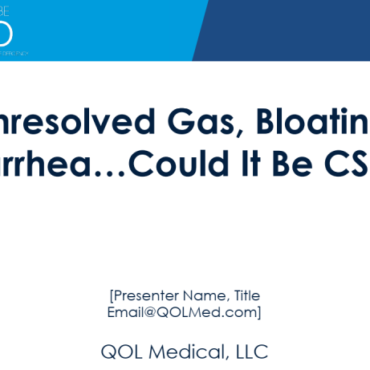Diagnosing CSID
In order to diagnose Congenital Sucrase-Isomaltase Deficiency (CSID), a careful review of signs, symptoms, and medical history must be performed first to determine whether a diagnostic workup for sucrase-isomaltase enzyme deficiency is warranted. The diagnostic workup can include a sucrase assay of intestinal biopsy samples, a carbon-13 sucrose breath test (13C SBT), a sucrose hydrogen-methane breath test, an oral sucrose challenge test, or a therapeutic trial of sacrosidase enzyme replacement.
Common Signs and Symptoms
A medical history will include a review of a patient’s complaints. Patients with CSID typically present with one or more of the following symptoms:
- Chronic diarrhea and/or loose stools (acidic diarrhea, and more severe or explosive diarrhea in young children or babies after weaning)
- High bowel movement frequency
- Reports of particularly foul stool odor due to malabsorption
- Gas/bloating
- Abdominal pain
- Complaints of nausea or dyspepsia
- Diarrhea mixed with intermittent constipation, particularly when chronically taking common antidiarrheal therapies
- Postprandial symptoms
- A low body mass index (BMI) that falls below an age-appropriate growth chart curve, or failure to thrive when very young
- Carbohydrate food avoidance or intolerance, particularly sugary sweets or starches (eg, potatoes, rice, or pasta)
- Lack of response to common antidiarrheal therapies
- Long history of diagnostic workups with multiple gastroenterologists for unusual, but similarly presenting, pathologies such as cholecystitis, celiac disease, cystic fibrosis, and bile acid malabsorption
Symptom Frequency and Duration
- Patients often report a high frequency of daily and weekly symptoms
- Symptoms typically occur after meals (postprandial)
- Symptoms have a very long-term duration, since childhood or for many years. In children, symptoms may start after weaning, with increased consumption of dietary carbohydrates in baby foods
Diagnostic Tools to Assess Sucrase Enzyme Activity
Sucrase Assay via Small Bowel Biopsy and Disaccharidase Assay
This assay is performed on tissue biopsy samples obtained from the distal duodenum at the time of an esophagogastroduodenoscopy. Sucrase activity is considered abnormal when it is below the 10th percentile (<25 U per gram of protein, or <25 µM of sucrose converted per minute per gram of protein).1 However, a sucrase deficiency should also be considered when sucrase activity is below the 20th percentile (<33 U/g) if clinical symptoms are present.
Carbon-13 Sucrose Breath Test (13C SBT)
This is a noninvasive test that is relatively short in duration and can be administered by the patient in their home. Sucrase activity is considered abnormal when, after consuming a 20-g sucrose solution, a cumulative [13C] CO2 exhalation over 90 minutes is below the 10th percentile, which is <3.9% for men and <5.2% for women.2 Patients with sucrase deficiency may experience symptoms caused by the large consumption of sucrose associated with the test.
Sucrose Hydrogen-Methane Breath Test
This is another noninvasive test that can be administered by the patient in their home. The test result is positive for diminished or absent sucrase activity when, after consuming a 50-g sucrose solution, the sequential net increase over baseline values in exhaled hydrogen is >20 ppm, exhaled methane is >10-15 ppm, or exhalation of both are >15 ppm during a 3-hour period.3,4 Patients who are sucrase deficient will likely have gastrointestinal symptoms during or shortly after this test, caused by the consumption of 50 g of sucrose at the beginning of this test. It is advised that the very young, very old, and those who have diabetes not take this test.
4-4-4 Oral Sucrose Challenge Test
This is a third noninvasive test that can be administered by the patient in their home. A fasting patient simply drinks a well-dissolved solution of 4 tablespoons of table sugar in a 4-ounce glass of water. If sucrase activity is diminished or absent, the patient will experience the gastrointestinal symptoms associated with colonic fermentation of the sucrose, such as gas, bloating, distention, and diarrhea. Additional workup to assess CSID with a breath test or disaccharidase assay should be considered when moderate or severe symptoms occur within the first 4 hours. This test is not appropriate for infants, young children, and geriatric patients, and those with comorbid conditions. Patients may have severe symptoms if they are very sensitive to sugar.
Therapeutic Trial of Sacrosidase Enzyme Replacement
It may sometimes be clinically inappropriate, difficult, or inconvenient to perform a small bowel biopsy or breath hydrogen test to make a definitive diagnosis of CSID. If the diagnosis is in doubt, it may be warranted to conduct a short therapeutic trial (eg, one week) with Sucraid® (sacrosidase) Oral Solution to assess response in a patient suspected of sucrase deficiency.5
| For additional information or to order a test, please contact one of our Disease Specialists at 1-800-705-1962, M-F 8 am to 5 pm ET. |
- Quezada-Calvillo R, Robayo-Torres CC, Ao Z, et al. Luminal substrate ‘‘brake’’ on mucosal maltase-glucoamylase activity regulates total rate of starch digestion to glucose. J Pediatr Gastroenterol Nutr. 2007;45(1):32-43. doi:10.1097/MPG.0b013e31804216fc
- QOL Medical. Data on file. Pelton N, Tran C, Leo A, et al. The reproducibility of the 13C-sucrose breath test in children and adults. 2009.
- Davidson GP, Robb TA. Value of breath hydrogen analysis in management of diarrheal illness in childhood: comparison with duodenal biopsy. J Pediatr Gastroeneteol Nutr. 1985;4(3);381-7. doi:10.1097/00005176-198506000-00010
- Hamilton LH. Breath Tests & Gastroenterology, second edition. Milwaukee, WI: QuinTron Instrument Company; 1998.
- Sucraid® [package insert]. Vero Beach, FL: QOL Medical, LLC; 2023.




